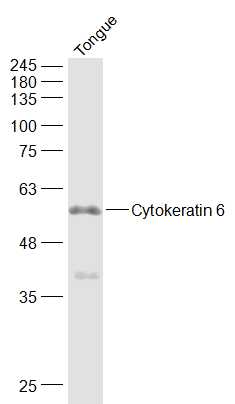
Rabbit Anti-Cytokeratin 6 antibody
KRT6A; CK6A; CK6B; CK6C; CK6D; CK 6E; K6A; CK6; K6C; K6D; KRT6C; Cytokeratin 6a; Cytokeratin 6B; Cytokeratin 6C; Cytokeratin 6D; Cytokeratin 6E; Cytokeratin6; Cytokeratin 6; k6a keratin; K6B; K6b keratin; K6c keratin; K6d keratin; K6e keratin; k6hf; Kerat
View History [Clear]
Details
Product Name Cytokeratin 6 Chinese Name 细胞角蛋白6抗体 Alias KRT6A; CK6A; CK6B; CK6C; CK6D; CK 6E; K6A; CK6; K6C; K6D; KRT6C; Cytokeratin 6a; Cytokeratin 6B; Cytokeratin 6C; Cytokeratin 6D; Cytokeratin 6E; Cytokeratin6; Cytokeratin 6; k6a keratin; K6B; K6b keratin; K6c keratin; K6d keratin; K6e keratin; k6hf; Keratin 6 isoform K6e; Keratin 6C; Keratin 6E; Keratin K6h; Keratin type II cytoskeletal 6A; Keratin type II cytoskeletal 6B; Keratin type II cytoskeletal 6C; Keratin type II cytoskeletal 6D; Keratin type II cytoskeletal 6E; KRT6; KRT6A; KRT6B; KRT6C; KRT6D; KRT6E; MGC102925; K2C6A_HUMAN. literatures Research Area Tumour Signal transduction Immunogen Species Rabbit Clonality Polyclonal React Species Mouse, (predicted: Human, Rat, Pig, Cow, Horse, Rabbit, Sheep, ) Applications WB=1:500-2000 IHC-P=1:100-500 (Paraffin sections need antigen repair)
not yet tested in other applications.
optimal dilutions/concentrations should be determined by the end user.Theoretical molecular weight 60kDa Cellular localization cytoplasmic Form Liquid Concentration 1mg/ml immunogen KLH conjugated synthetic peptide derived from human Cytokeratin 6: 401-500/564 Lsotype IgG Purification affinity purified by Protein A Buffer Solution 0.01M TBS(pH7.4) with 1% BSA, 0.03% Proclin300 and 50% Glycerol. Storage Shipped at 4℃. Store at -20 °C for one year. Avoid repeated freeze/thaw cycles. Attention This product as supplied is intended for research use only, not for use in human, therapeutic or diagnostic applications. PubMed PubMed Product Detail The protein encoded by this gene is a member of the keratin gene family. The type II cytokeratins consist of basic or neutral proteins which are arranged in pairs of heterotypic keratin chains coexpressed during differentiation of simple and stratified epithelial tissues. As many as six of this type II cytokeratin(KRT6) have been identified; the multiplicity of the genes is attributed to successive gene duplication events. The genes are expressed with family members KRT16 and/or KRT17 in the filiform papillae of the tongue, the stratified epithelial lining of oral mucosa and esophagus, the outer root sheath of hair follicles, and the glandular epithelia. This KRT6 gene in particular encodes the most abundant isoform. Mutations in these genes have been associated with pachyonychia congenita. The type II cytokeratins are clustered in a region of chromosome 12q12-q13. [provided by RefSeq].
Subunit:
Heterodimer of a type I and a type II keratin. KRT6 isomers associate with KRT16 and/or KRT17. Interacts with TCHP.
Tissue Specificity:
Constitutively expressed in distinct types of epithelia such as those in oral mucosa, esophagus, papillae of tongue and hair follicle outer root sheath.
DISEASE:
Defects in KRT6A are a cause of pachyonychia congenital type 1 (PC1) [MIM:167200]; also known as Jadassohn-Lewandowsky syndrome. PC1 is an autosomal dominant ectodermal dysplasia characterized by hypertrophic nail dystrophy resulting in onchyogryposis (thickening and increase in curvature of the nail), palmoplantar keratoderma, follicular hyperkeratosis, and oral leukokeratosis. Hyperhidrosis of the hands and feet is usually present.
Similarity:
Belongs to the intermediate filament family.
SWISS:
P02538
Gene ID:
286887
Database links:Entrez Gene: 286887 Human
Entrez Gene: 3853 Human
Entrez Gene: 3854 Human
Entrez Gene: 16687 Mouse
Entrez Gene: 16688 Mouse
Omim: 148041 Human
Omim: 148042 Human
Omim: 612315 Human
SwissProt: P02538 Human
SwissProt: P04259 Human
SwissProt: P48668 Human
SwissProt: P50446 Mouse
SwissProt: Q9Z331 Mouse
Unigene: 700779 Human
Unigene: 709234 Human
结构蛋白(Structural Proteins)细胞角蛋白是一类与结构相关的蛋白家族,其在epithelial cells中形成Cytoskeleton中间丝。CK6表达于鳞状epithelial cells,特别是增生的鳞状上皮。76%的脑、颈部鳞状细胞癌病例中有CK6的表达。Product Picture
References (0)
No References
Bought notes(bought amounts latest0)
No one bought this product
User Comment(Total0User Comment Num)
- No comment



 +86 571 56623320
+86 571 56623320
 +86 18668110335
+86 18668110335

